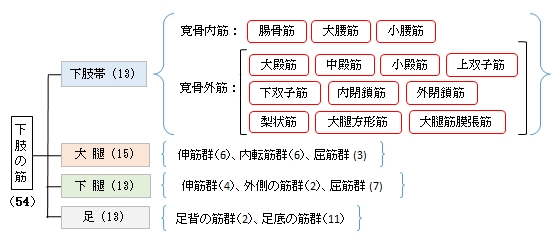大腿筋膜張筋 ( だいたいきんまくちょうきん、英: tensor fasciae latae )
・ 概 要 |
・ 作 用 |
・ イラスト掲載サイト |
|
・ イラスト |
・ 神経 / 脈管 |
||
・ 起始 / 停止 |
・ Wikipedia |
![]()



・「この筋は、その起始ではもともとあった中臀筋とのつながりを保っている。」(船戸和也のHP)
筋連結 : 大殿筋、中殿筋、小殿筋、外側広筋、足底筋、縫工筋、腸骨筋
![]()
 |
|
 |
![]()
【 停 止 】 : 「脛骨の外側顆(日本人体解剖学)」 ※腸脛靭帯を介して
「大腿筋膜に停止する。大腿筋膜中で、その線維は腸脛靱帯の一部を作り、脛骨外側顆および腓骨顆にまで達する。また、大腿骨へは外側筋膜中隔を介して達し、外側膝蓋支帯に放散する。」(船戸和也のHP)
![]()
「大腿筋膜を張る。下腿を伸ばすと脛骨を外転する。 」 ( 日本人体解剖学 )
![]()
・ 神 経 : 上殿神経 (L4,L5,S1) ※S2を含むこともある。
・ 脈 管 : 外側大腿回旋動脈
The tensor fasciae latae (or tensor fasciæ latæ or, formerly, tensor vaginae femoris) is a muscle of the thigh. Together with the gluteus maximus, it acts on the iliotibial band and is continuous with the iliotibial tract, which attaches to the tibia. The muscle assists in keeping the balance of the pelvis while standing, walking, or running.
【Structure】
It arises from the anterior part of the outer lip of the iliac crest; from the outer surface of the anterior superior iliac spine, and part of the outer border of the notch below it, between the gluteus medius and sartorius; and from the deep surface of the fascia lata.
It is inserted between the two layers of the iliotibial tract of the fascia lata about the junction of the middle and upper thirds of the thigh. The tensor fasciae latae tautens the iliotibial tract and braces the knee, especially when the opposite foot is lifted. The terminal insertion point lies on the lateral condyle of the tibia.
【Nerve supply】
Tensor fasciae latae is innervated by the superior gluteal nerve, L5 and S1. At its origins of the anterior rami of L4, L5, and S1 nerves, the superior gluteal nerve exits the pelvis via greater sciatic foramen superior to the piriformis. The nerve also courses between the gluteus medius and minimus. The superior gluteal artery also supplies the tensor fasciae latae. The superior gluteal nerve arises from the sacral plexus and only has muscular innervation associated with it. There is no cutaneous innervation for sensation that stems from the superior gluteal nerve.
【 語 句 】
・gluteus maximus:大殿筋 ・iliotibial band:腸脛靭帯 ・tibia:脛骨 ・pelvis:骨盤 ・gluteus medius:中殿筋 ・sartorius:縫工筋 ・fascia lata:大腿筋膜 ・tauten:引きつる ・brace:補強する、ピンと張る ・lateral condyle:外側顆 ・superior gluteal nerve:上殿神経 ・anterior rami:前枝 ・greater sciatic foramen:大坐骨孔 ・piriformis:梨状筋 ・superior gluteal artery:上殿動脈 ・sacral plexus:仙骨神経叢
【Function】
The tensor fasciae latae is a tensor of the fascia lata; continuing its action, the oblique direction of its fibers enables it to stabilize the hip in extension (assists gluteus maximus during hip extension). The fascia lata is a fibrous sheath that encircles the thigh like a subcutaneous stocking and tightly binds its muscles. On the lateral surface, it combines with the tendons of the gluteus maximus and tensor fasciae latae to form the iliotibial tract, which extends from the iliac crest to the lateral condyle of the tibia.
In the erect posture, acting from below, it will serve to steady the pelvis upon the head of the femur; and by means of the iliotibial tract it steadies the condyles of the femur on the articular surfaces of the tibia, and assists the gluteus maximus in supporting the knee in a position of extension.
The basic functional movement of tensor fasciae latae is walking. The tensor fasciae latae is heavily utilized in horse riding, hurdling and water skiing. Some problems that arise when this muscle is tight or shortened are pelvic imbalances that lead to pain in hips, as well as pain in the lower back and lateral area of knees.
Because of its insertion point on the lateral condyle of the tibia, it also aids in the lateral rotation of the tibia. This lateral rotation may be initiated in conjunction with hip abduction and medial rotation of the femur while kicking a soccer ball. The tensor fasciae latae works in synergy with the gluteus medius and gluteus minimus muscles to abduct and medially rotate the femur.
The TFL is a hip abductor muscle. To stretch the tensor fasciae latae, the knee may be brought medially across the body (adducted). If one leans against a wall with crossed legs (externally/laterally rotated hips) and pushes the pelvis away from the wall (leaning the upper body towards it) sidebending the lumbar spine (i.e.: curving the spine to the side) should be avoided as it stretches the lumbar region rather than the tensor fasciae latae and other muscles which cross the hip rather than the spine.
【 語 句 】
・sheath:鞘 ・subcutaneous:皮下の ・iliac crest:腸骨稜 ・erect posture:直立姿勢 ・head of the femur:大腿骨頭 ・utilize:役立たせる ・hurdling:障害物競走 ・in conjunction with~:~と合わせて ・synergy:共同作用
![]()






